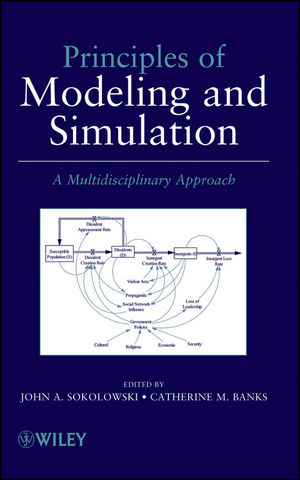
Principles of Modeling and Simulation
John Wiley & Sons Inc (Verlag)
978-0-470-28943-3 (ISBN)
Explores wide-ranging applications of modeling and simulation techniques that allow readers to conduct research and ask "What if?" Principles of Modeling and Simulation: A Multidisciplinary Approach is the first book to provide an introduction to modeling and simulation techniques across diverse areas of study. Numerous researchers from the fields of social science, engineering, computer science, and business have collaborated on this work to explore the multifaceted uses of computational modeling while illustrating their applications in common spreadsheets.
The book is organized into three succinct parts:
Principles of Modeling and Simulation provides a brief history of modeling and simulation, outlines its many functions, and explores the advantages and disadvantages of using models in problem solving. Two major reasons to employ modeling and simulation are illustrated through the study of a specific problem in conjunction with the use of related applications, thus gaining insight into complex concepts.
Theoretical Underpinnings examines various modeling techniques and introduces readers to two significant simulation concepts: discrete event simulation and simulation of continuous systems. This section details the two primary methods in which humans interface with simulations, and it also distinguishes the meaning, importance, and significance of verification and validation.
Practical Domains delves into specific topics related to transportation, business, medicine, social science, and enterprise decision support. The challenges of modeling and simulation are discussed, along with advanced applied principles of modeling and simulation such as representation techniques, integration into the application infrastructure, and emerging technologies.
With its accessible style and wealth of real-world examples, Principles of Modeling and Simulation: A Multidisciplinary Approach is a valuable book for modeling and simulation courses at the upper-undergraduate and graduate levels. It is also an indispensable reference for researchers and practitioners working in statistics, mathematics, engineering, computer science, economics, and the social sciences who would like to further develop their understanding and knowledge of the field.
John A. Sokolowski, PhD, is Research Professor and Director of Research at the Virginia Modeling, Analysis, and Simulation Center (VMASC) at Old Dominion University. He has authored numerous journal articles on the use of modeling and simulation techniques in the fields of engineering, computer science, and human behavior representation. Catherine M. Banks, PhD, is Research Assistant Professor at the Virginia Modeling, Analysis, and Simulation Center (VMASC) at Old Dominion University. The author of many published articles on modeling and simulation, Dr. Banks currently focuses her research on modeling states and their varied histories of revolution and insurgency, political economy and state volatility, and global warming and population dynamics.
Preface. Contributors.
PART ONE: PRINCIPLES OF MODELING AND SIMULATION: A MULTIDISCIPLINARY APPROACH.
Chapter 1: What is Modeling and Simulation?
Introduction.
Models: Approximations of Real World Events.
A Brief History of Modeling and Simulation.
Application Areas.
Using Modeling and Simulation: Advantages and Disadvantages.
Conclusion.
Key Terms.
Further Reading.
References.
Chapter 2: The Role of Modeling and Simulation.
Introduction.
Using Simulations to Solve Problems.
Uncertainty and Its Effects.
Gaining Insight.
A Simulation’s Lifetime.
Conclusion.
Key Terms.
Further Reading.
PART TWO: THEORETICAL UNDERPINNINGS.
Chapter 3: Simulation: Models That Vary Over Time.
Introduction.
Discrete Event Simulation.
Continuous Simulation.
Conclusion.
Key Terms.
References.
Chapter 4: Queue Modeling and Simulation.
Introduction.
Analytical Solution.
Queuing Models.
Sequential Simulation.
SimPack Queuing Implementation.
Parallel Simulation.
Conclusion.
Key Terms.
Further Reading.
References.
Chapter 5: Human Interaction with Simulations.
Introduction.
Simulation and Data Dependency.
Visual Representation.
Conclusion.
Key Terms.
References.
Chapter 6: Verification and Validation.
Introduction.
Performing Verification and Validation.
Verification and Validation Examples.
Conclusion.
Key Terms.
References.
PART THREE: PRACTICAL DOMAINS.
Chapter 7: Uses of Simulation.
Introduction.
The Many Facets of Simulation.
Experimentation Aspect of Simulation.
Experience Aspect of Simulation.
Examples of Uses of Simulation.
Ethics in the Use of Simulation.
Some Excuses to Avoid Simulation.
Conclusion.
Key Terms.
Further Exploration.
References.
Appendix A-Simulation Associations/Groups/Research Centers.
CHAPTER 8: MODELING AND SIMULATION: REAL-WORLD EXAMPLES.
Introduction.
Transportation.
Business M&S.
Medical M&S.
Social Science M&S.
Conclusion.
Key Terms.
Further Reading.
References.
Chapter 9: The Future of Simulation.
Introduction.
A Brief . . . and Selective . . . History of Simulation.
Convergent Simulations.
Serious Games.
Human-Simulator Interfaces.
Computing Technology.
The Role of Education in Simulation.
The Future of Simulation.
Index.
| Erscheint lt. Verlag | 6.3.2009 |
|---|---|
| Zusatzinfo | Charts: 17 B&W, 0 Color; Photos: 16 B&W, 0 Color; Drawings: 11 B&W, 0 Color; Screen captures: 19 B&W, 0 Color; Graphs: 15 B&W, 0 Color |
| Verlagsort | New York |
| Sprache | englisch |
| Maße | 165 x 241 mm |
| Gewicht | 531 g |
| Themenwelt | Mathematik / Informatik ► Mathematik ► Angewandte Mathematik |
| Mathematik / Informatik ► Mathematik ► Wahrscheinlichkeit / Kombinatorik | |
| Technik ► Elektrotechnik / Energietechnik | |
| ISBN-10 | 0-470-28943-0 / 0470289430 |
| ISBN-13 | 978-0-470-28943-3 / 9780470289433 |
| Zustand | Neuware |
| Haben Sie eine Frage zum Produkt? |
aus dem Bereich



